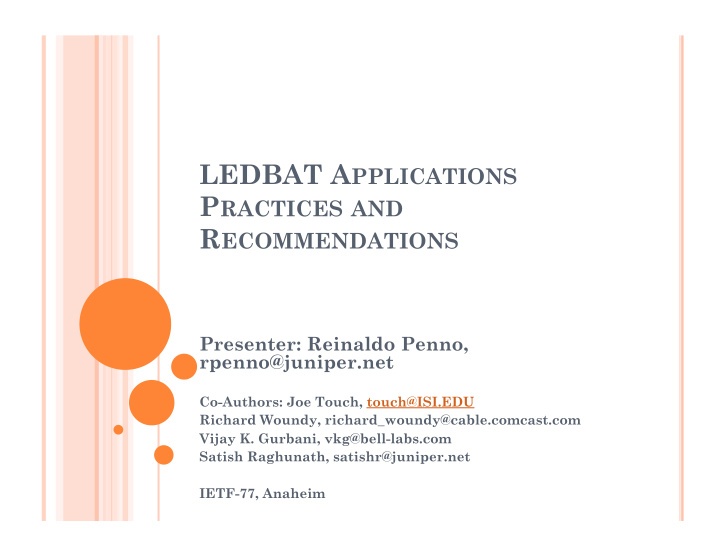



LEDBAT A PPLICATIONS P RACTICES AND R ECOMMENDATIONS Presenter: Reinaldo Penno, rpenno@juniper.net Co-Authors: Joe Touch, touch@ISI.EDU Richard Woundy, richard_woundy@cable.comcast.com Vijay K. Gurbani, vkg@bell-labs.com Satish Raghunath, satishr@juniper.net IETF-77, Anaheim
F EEDBACK FROM IETF-76 Clearly state what is current practice vs. best recommendations Discuss which recommendations are due to defective implementations vs. open problems Whether ‘user control’ be a recommendation. Diffserv in another document (done)
C URRENT PRACTICE – M ULTIPLE TCP CONNECTIONS Browsers open multiple TCP connections per domain to download content Web Servers divide content in multiple domains to allow content to be downloaded in parallel Clients (download managers) open multiple connections to download content http://en.wikipedia.org/wiki/ Comparison_of_download_managers
F IREFOX NUMBER OF C ONNECTIONS
I NTERNET E XPLORER “By default, Windows Internet Explorer 7 and earlier versions limit the number of files that you can download at one time to two. Windows Internet Explorer 8 limits the number of files that you can download at one time to six. This change reflects the faster connection speeds that are now typical for most users. For dial-up connections, the limits from earlier versions still apply.” http://support.microsoft.com/kb/282402 http://msdn.microsoft.com/en-us/library/ cc304129(VS.85).aspx
I NTERNET E XPLORER
C ONCURRENT C ONNECTIONS Source:Concurrency Test: http://cloudfour.com/mobile/
C URRENT PRACTICE – HTTP P IPELINING Not used in any significant way today on the Internet Comes disabled on most browsers http://en.wikipedia.org/wiki/HTTP_pipelining
C URRENT PRACTICE – WINDOW SCALE Widely implemented and enabled by default in desktop OSs Not clear how much is used in the wild A project is in the works to find out which TCP options are actually used in the wild. Results at the next IETF.
C URRENT PRACTICE – U SER C ONTROL Today users already have a good deal of control over how many connections are opened by both Web Browsers (as seen in previous slides) and P2P Clients
R ECOMMENDATIONS - W INDOW S CALE REC-2: Where appropriate, sender & receiver window should be scaled using RFC1323 based negotiation in order to make the best use of network resources. Recommendations to adjust window size are not new and have been recommended in networks where the BDP (Bandwidth Delay Product) is large [RFC3481].
R ECOMMENDATIONS – M ULTIPLE CONCURRENT C ONNECTIONS REC-3: Applications in general should not open more than 6 connections to download the same object. Does this new working address the concerns raised in the previous meeting?
R ECOMMENDATIONS – HTTP P IPELINING REC-4: HTTP based applications should use HTTP/ 1.1 pipelining when transferring multiple small objects from the same server. We can recommend HTTP Pipelining but whether it will be adopted given the current Internet model is to be determined. The trend today is to not be adopted. There are some initiatives to overcome HOL and multiple connections using a protocol on top of HTTP http://dev.chromium.org/spdy/spdy-protocol/spdy-protocol- draft2. http://devcentral.f5.com/weblogs/macvittie/archive/ 2009/11/17/google-spdy-protocol-would-require-mass- change-in-infrastructure.aspx
R ECOMMENDATIONS – U SER C ONTROL REC-5: Application developers should provide users with a way to configure the number of concurrent TCP connections used to transfer a single object.
O THER R ECOMMENDATIONS Should we recommend GZIP compressions by Web Servers in some cases? http://devcentral.f5.com/weblogs/macvittie/ archive/2009/05/27/i-am-wondering-why-not-all- websites-enabling-this-great.aspx Bi-directional HTTP HyBi working group effort at IETF
Recommend
More recommend